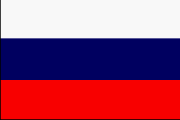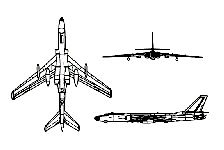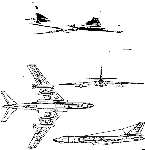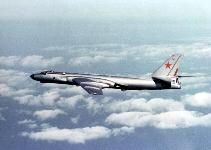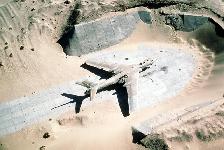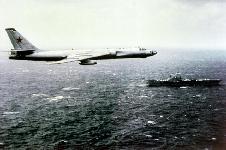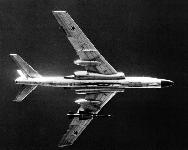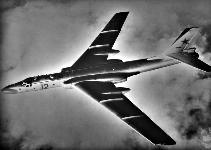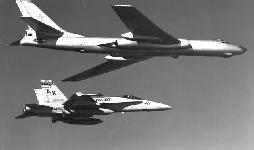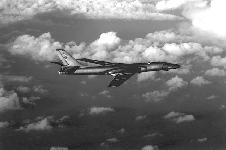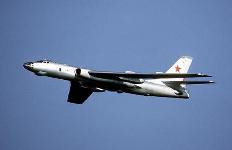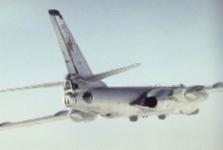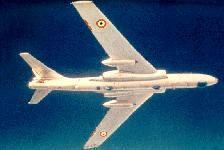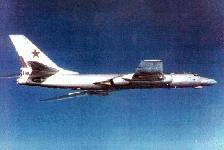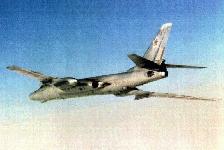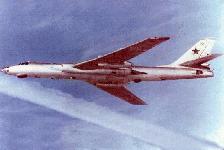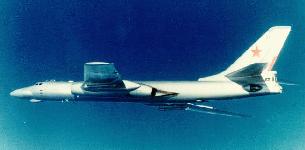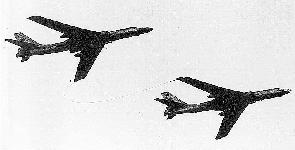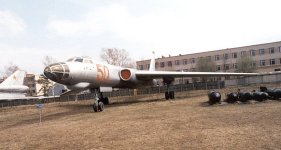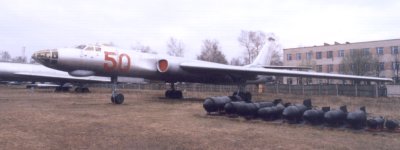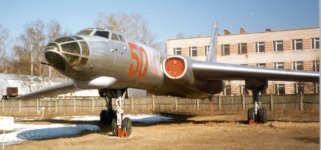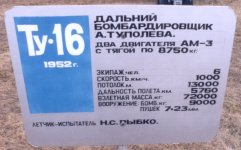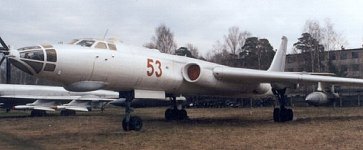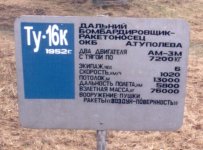Tu-16 BADGER (TUPOLEV)
The Tu-16 was designed as an high-speed jet bomber for operations in theaters close to the Soviet Union. Intended to replace the propeller-driven TU-4, the greatest challenge during development was to doubling the speed to improve survivability in the face of enemy fighters.
OKB A.N. Tupolev started working on the design of a new jet bomber soon after development of the TU-4 was completed. The resulting design "82" consisted of a swept-wing aircraft with RD-45F or VK-1 turbojet engines. The bomber was supposed to have a speed of Mach 0.9-0.95 with a range and payload were comparable to the TU-4.
After the bomber's operational characteristics were coordinated with the military, the government officially approved the development of the "82" aircraft in 1948. The prototype, which was the first Soviet aircraft with swept-wings, made its' first flight on 24 March1949. It reached a speed of 934 km/h, 20 percent faster than the TU-14 which also had BK-1 engines. The "82" design was initially supposed to serve as the basis for the "83" bomber, but with the start of serial production of the Il-28, the project was dropped.
Based on the results of the "82" aircraft, in 1950 OKB Tupolev started developing the "492" heavy long-range bomber that had a better performance than the TU-4 and the Il-28. The design provided for a bomb load of 6000 kg, a range of 7,500 km, a speed of 1000 km/h and a ceiling of 12000-13000 m. The maximum bomb load could be increased up to 12000kg. The aircraft could be outfitted with three different types of engines: two AM-3 engines with a thrust of 8750 kg, 4 engines ТR-3A engines (5000 kg) or 4 TR-5 two circuit engines (5000 kg). As the TR-5 engines were the most reliable at that time, Tupolev was charged with the development of an experimental long-range bomber (project "88") equipped with two TR-5 engines. However, work on the AM-3 engines continued and was completed in August 1951.
The wings of the Badger are mid-mounted, swept-back, and tapered with blunt tips. There are fences on top of the wings and its landing gear pods extend beyond the wings� trailing edges. The Badger's engine(s) are two turbojets mounted in wing roots which extend beyond the leading and trailing edges of the wing root. The engines also have round air intakes. Its fuselage is long, slender, and bulging where the engines are mounted and tapered to the tail. It has a round, glassed-in nose and a stepped cockpit. The tail is swept-back, tapered fin and flats with blunt tips. The Badger also has a tail gunner compartment. All models of Badger are equipped for aerial refueling.
The first prototype of the "88" aircraft received the designation Tu-16 and carried out the first flight on 27 April 1952. During flight tests, the aircraft exceeded the expected speed but lagged in range due to insufficient engine performance. As a result, the second prototype had a reduced weight though less speed at small and medium altitudes. In April 1953 it actually exceeded the expected range.
In December 1952, series production was initiated. In 1953 series production of the TU-16 began at the plant Nr. 22 in Kazan and in 1954, also at the plant Nr.1 in Kuibyshev and at the plant Nr. 64 in Voronezh. During production, the aircraft were outfitted with a modified AM-3 engine - the PD-3MT. While the bombers were already operational, the AM-3 and PD-3M engines were replaced by PD-3M-500 engines with improved characteristics. When production of the TU-16 finally stopped in 1963, a total of 1509 aircraft had been built.
Deployment of the first TU-16 bombers started in 1954. They replaced the TU-4, operating in theaters close to Soviet territory.
- Badger-A - Tu-16 -- The initial production version was lighter than the first prototype, and largely met the original performance requirement.
- Badger-A - Tu-16A -- Primarily employed as a medium bomber, the TU-16A carried nuclear bombs - the A suffix stood for Atomic. It had a re-configurable thermostatically controlled heated bomb bay compatible with nuclear weapons, and a special skin for protection against nuclear thermal effects. Externally similar to the basic Tu-16, it featured more powerful RD-3M-200 engines, and an improved self-defense gun fire control system. This was the primary production version, with over 700 built, many of which were subsequently converted to other versions.
- Badger-A - Tu-16E -- To increase range, the TU-16 subsequently received an air refueling system. Some TU-16 were converted into tanker aircraft, which were first tested in 1955 and received the designation TU-16E [some Western sources suggest the designation was Tu-16Z]. However, they could still be used as bombers. This initial inflight refuelling tanker version used a novel "wingtip-to-wingtip" method, with a hose trailed from the right wingtip and snagged by grapnel trailed by receiver, then winched into fitting in receiver's port wingtip. It also had provision for additional transfer fuel in removeable tanks in bomb bay.
- Badger-A - Tu-16M -- The Tu-16M AV-MF maritime strike version was similar to the Tu-16A with a few minor differences.
- Badger-A - Tu-16N -- A secondary mission for Badger A is as a tanker. From 1963 on the TU-16 was converted into TU-16N tanker aircraft. This tanker version featured a 'Probe and drogue' system with a Yakovlev-built centerline fueling unit in the bomb bay and ARK-5 beacon. It was mainly used to support probe-equipped Tu-22 and Tu-22M Blinder bomber regiments.
- Badger-A - Tu-16T -- In the middle of the 1950s series production of the TU-16T started. It was equipped with an air-to-surface missile for anti-shipping purposes, with provision for mines, depth charges or for four RAT-52 or TAN-53 torpedos. This torpedo bomber version was built in limited numbers, and after 1965 all TU-16T aircraft were converted into the TU-16S.
- Badger-A - Tu-16S -- The Tu-16S search and rescue model, a 1965 conversion of all the TU-16T aircraft, featured additional fuel and extra radios and carried a radio-controlled lifeboat in the bomb compartment.
- Badger-A - Tu-16Ye -- In the middle of the 1950s, the TU-16N and the TY-16Ye were created for electronic warfare. The Yolka ECM system featured a row of three steerable antennas under the bomb bay and a bulk chaff-cutter/dispenser. This aircraft is designated Badger-K when fitted with two radomes rather than three. A few Tu-16As were rebuilt as Elint/EW platforms, though most Tu-16Ye were produced by conversion of redundant Tu-16K-10 missile Badger-D carriers.
- Badger-B - Tu-16KS -- The Badger B is equipped with two Kennel air-to-surface missiles suspended beneath the wings. The TU-16KS began initial tests in August 1954. It carried two KS-1 Kometa air-to-surface missiles with a range of 90 km, and had an operational range of 1800 km. The Kobalt-N guidance transmitter was installed, though the glazed 'bomber' nose was retained. The aircraft subsequently served in the Soviet Naval Air Force [AV-MF].
- Badger-C - Tu-16K-10 -- In 1955 work began on using the Tu-16 as the carrier for the K-10S (AS-2 Kipper) cruise missile for the Soviet Naval Air Force for use in an anti-shipping role. The missile's guidance system was added as an onboard system, with the missile mounted semi-submerged under the fuselage on the centerline in the bomb bay area. The glazed nose was replaced by broad flat radome housing antenna for the YeN targeting radar. A missile top-off fuel tank was housed in the bomb bay, along with a small pressure cabin for the YeN radar operator. The TU-16K-10 prototype was finished in 1958 and series production started in 1959. Deployment into the Soviet Naval Air Force began in October 1961. A total of about 220 were built, many of which were subsequently converted to Elint/EW platforms.
- Badger-C (Mod) - Tu-16K-10-26 -- Small numbers of Tu-16K-10s were later modified to carry KSR-2, KSR-5S and later K-26 missiles underwing.
- Badger-D - Tu-16Ye -- Badger D is a modified Badger C reequipped to perform an ELINT reconnaissance mission. This EW conversion of Tu-16K-10 and K-10-26 is generally similar to Tu-16A and Tu-16KS-based EW conversions (Tu-16Ye 'Badger-A' and 'Badger-B'), though retaining the distinctive broad flat nose radome.
- Badger-E - Tu-16R -- The TU-16R reconnaissance aircraft represented another modification of the TU-16 Badger which was tested from 1955 on. The Badger E is a modified Badger A reequipped to perform photographic reconnaissance, with a camera pack in former bomb bay and the pilot's forward firing gun usually removed.
- Badger-E - Tu-16RM -- The Tu-16RM is a similar maritime reconnaissance version for the Soviet Naval Air Force [AV-MF].
- Badger-E - Tu-16KRM -- Small numbers of Tu-16RMs were modified with underwing launch rails for rocket-powered target drones.
- Badger-F - Tu-16RM-2 -- Badger F is a photographic reconnaissance variant of the Badger E Tu-16Rs and RMs with the addition of ELINT pods beneath the wings or fuselage.
- Badger-G - Tu-16K-11-16 -- The Badger G has the concurrent capability of carrying two Kelt AS-5 (125 nm) or two AS-6 (300 nm) air-to-surface missiles suspended beneath the wings and dropping bombs from an internal bomb bay. The new missile system K-11-16 with KSR-2 (AS-5B) and KSR-11 (AS-5B) missiles and the "Rubin-1" radar system was developed in 1962 based on a modification of equipment of the MIG-15. The Badger G/Kelt weapon system was developed as a stand-off weapon for the LRA and for an anti-shipping role for the SNAF. It probably has an anti-radiation role also. The AS-6 would have similar roles. It is equipped for aerial refueling. A number of Tu-16As and Tu-16KSs were re-fitted with Rubin radar undernose and with provision for K-11 or K-16 missiles. The TU-16K-11-16 aircraft that were converted from TU-16, TU-16A and TU-16KS aircraft could carry either two KSR-2 or KSR-11 missile beneath the wings. They served in the Soviet Naval Air Force.
- Badger-G (Mod) Tu-16K-26 -- Development of the K-26 missile system started in 1962, using the KSR-5 (AS-6) air-to-surface anti-ship missiles. They were deployed on TU-16K-26 aircraft that entered service in the second half of the 1960s. The Tu-16K-26 aircraft was modified to launch K-26 missiles, with launch attitude indicator on the nose glazing. The characteristics of the K-11-16 and K-26 weapon systems allowed the aircraft to retain their original bomber capabilities.
- Badger-G (Mod) Tu-16K-10-26 -- During development of the TU-16K-26, the K-10 weapon system was upgraded and replaced by the K-10S system that had two KRS-5 or KSR-2 missiles. The retrofitted aircraft received the designation TU-16K-10-26. After the K-10S system missiles were phased out, these aircraft carried only KSR-5 missiles.
- Badger-H - Tu-16PP or Tu-16P Elka -- The Badger H is believed to be an ECM support aircraft with a primary mission of sowing chaff corridors to protect follow-on weapons-carrying aircraft. It also has a limited capability to provide active ECM against search and acquisition radars. This stand-off jammer version was produced by conversion of Tu-16A or Tu-16KS, with underfuselage radomes at each end of the bomb bay, and with a new bulk chaff-cutter/dispenser serving three chutes in the former bomb bay doors.
- Badger-J - Tu-16P Buket -- The Badger J active jamming platform is estimated to carry a multichannel click jammer to perform both stand-off and escort-active ECM. It features a ventral canoe fairing and flat plate antennas forming wingtip extensions.
- Badger-K - Tu-16Ye -- Badger K probably supplements Badger F and is probably an automatic system designed for precision ELINT collection in a dense signal environment. This EW conversion of Tu-16KS is generally similar to Tu-16Ye Badger-B, though with two rather than three underfuselage radomes mounted on the area of the former bomb bay [rather than at each end as on Badger-F].
- Badger-L - Tu-16P and Tu-16PP -- The Badger-L is an advanced ELINT platform with a self-protection active jammer and an associated thimble nose radome, along with a distinctive extended ECM tailcone.
The TU-16 remained in Soviet and later Russian service until 1993. They were used during the war in Afghanistan. The Badger is used by Egypt, Iraq, the People�s Republic of China (H-6), and Ukraine. In 1958, delivery of TU-16 bombers to China began, where series production received the designation H-6. In the summer of 1961, twenty TU-16KS were sold to Indonesia. In the 1960s, TU-16 bombers were delivered to Egypt which also received TU-16KS aircraft in 1967 and Tu-16K-11-16 in 1973. Iraq also received TU-16K-11-16 bombers in the 1960s.
Specifications | |
| Design Bureau | OKB-156 Tupolev |
| Manufacturer | Plant Nr.22 Kazan Plant Nr. 1 Kuinyshevs Plant Nr. 64 Voronezh |
| Power Plant | 2 AM-3A Turbojet engines 2 PD-3M Turbojet engines 2 PD-3M-500 Turbojet engines |
| Thrust | 8,750 kg each 9,500 kg each 9,500 kg each |
| Length | 34.8 |
| Height | 10.36 |
| Wingspan | 33m |
| Wing surface | 164.65 sqm |
| Speed |
|
| Ceiling | 12,800m |
| Weight (empty) | 37,200kg |
| Fuel weight | 36,000kg |
| Maximum take-off weight | 79,000kg |
| Normal load | 3,000kg |
| Maximum load | 9,000kg |
| Operational Range | 5,800km (with a load of 3.000kg) 4,850km (with 2 missiles underneath the wings) |
| Range | 7,200 km |
| Aircraft Model | Operational Wt. Empty (lbs) | Fuel Capacity (gal) | Unrefueled Combat Radius | Payload (lb) | Altitude Over Target (ft) | Speed Cruise/ Combat (kn) | Remarks |
| Badger A | 83,500 | 11,200 | 1,450 | 10-30,000 | 40,400 | 445/500 | bomber |
| Badger B | 90,300 | 9,300 | 1,000 | 12,000 | 15,000 | 445/480 | Kennel ASM |
| Badger C | 86,600 | 10,300 | 1,350 | 9,100 | 39,400 | 445/480 | Kipper ASM |
| Badger D | 88,840 | 11,370 | n.a. | n.a. | n.a. | n.a. | ELINT Recce |
| Badger E | 85,000 | 11,570 | n.a. | n.a. | n.a. | n.a. | Photo Recce |
| Badger F | 87,000 | 11,570 | n.a. | n.a. | n.a. | n.a. | Photo/ELINT |
| Badger G | 86,000 | 9,460 | 1,100 | 17,620 | 38,100 | 445/495 | ASM |
| Badger H | 83,500 | 11,200 | n.a. | n.a. | n.a. | n.a. | ECM/Chaff |
| Badger J | 83,500 | 11,200 | n.a. | n.a. | n.a. | n.a. | ECM/Jammer |
| Badger K | 83,500 | 11,200 | n.a. | n.a. | n.a. | n.a. | ELINT |
Historical Review - Western Estimates |
|
| Estimated start of flight testing | 1953 |
| First discovery | |
| Badger A | 1953 |
| Badger B | July 1961 |
| Badger C | July 1961 |
| Badger D | September 1964 |
| Badger E | January 1963 |
| Badger F | 1959 |
| Badger G | July 14, 1966 |
| Badger H | March 1965 |
| Badger J | March 1965 |
| Badger K | September 1968 |
| Estimated start of series production | 1953 |
| Public display in significant numbers | May 1, 1954 |
| Initial operational capability | 1954 |
| Significant operational capability | 1955 |
Sources and Resources
- Russian Strategic Nuclear Weapons, Pavel Podvig, ed., IzdAT, Moscow, 1998, 492 pp. (in Russian). Authors: Oleg Bukharin, Timur Kadyshev, Eugene Miasnikov, Pavel Podvig, Igor Sutiagin, Maxim Tarasenko, Boris Zhelesov
- Tupolev Tu-16 'Badger' @ Encyclopedia of World Military Aircraft
- Tupolev Tu-16 'Badger'
- Tu-16K 'Badger'
- "A History of Strategic Arms Competition 1945-1972" (U), Volume 3, A Handbook Of Selected Soviet Weapon and Space Systems, United States Air Force, June 1976. pgs 26-33



